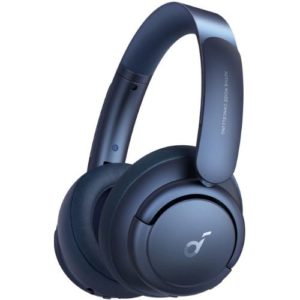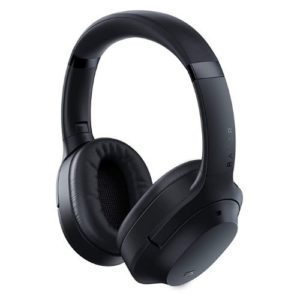Looking for reasonably priced ANC headphones? We compare two options to see which has the best performance. Read on for our full breakdown. It’s a face-off of the Soundcore Life Q35 vs. Razer Opus.
Design and Form Factor
Whether you’re a commuter looking to block out ambient noises or a fitness fan hoping to focus at the gym, comfort is key. When choosing the best noise-cancelling headphones, consider the shape of the ear cup, the padding, and the pressure on your ear.
Razer’s ANC headphones maintain comfort with an even sleeker design. In an update to the previous model, buttons like volume control are located only on the right ear cup. Plush leatherette memory foam ear cups ensure a personalized fit. The lightweight, padded headband clamps the headphones snugly in place for over-ear comfort. Fitness fans take note: despite the snug fit, these headphones don’t get hot during workouts. But the shallow ear cups may make larger ears uncomfortable.
Anker Soundcore Life’s Q35 also uses memory foam, and the lightweight build and midnight blue color mean long hours of comfortable, stylish use. As a bonus, the Soundcore Life Q35 ANC headphones have a built-in sensor that automatically detects when you remove them and pauses your audio. The headband’s thinner padding can wear out and clamping force is stronger than the previous model. Despite this, even mild workouts can shake off the Q35s, and mediocre breathability makes them sweat.
These two devices both have solid build quality, but the Razer Opus feels more sturdy. We’re not huge fans of the Q35’s look. They’re a decent-looking pair of headphones, but the protruding ear cups are a little off-putting. The Razer Opuz manages to maintain a minimal and modern design that we prefer.
Verdict: Razer Opus
Battery Life and Connectivity
When it comes to wireless headphones, battery life and wireless connectivity are necessary features for commuters, gym rats, and even couch potatoes. Key considerations here are how long it takes to charge the battery and how long that charge lasts. Luckly, constantly monitoring battery level shouldn’t be a concern with either of these devices.
The Razer Opus battery takes roughly four hours to fully charge. Advertised battery life is 30 hours with ANC enabled. We exceeded that and users have reported an outstanding 50+ hours. This makes the Razer Opus a great choice for long plane or bus rides. An auto-off timer ensures you don’t run the battery down after falling asleep. Great for gaming, these headphones have a special mode to keep your audio/visual in sync.
Anker Soundcore Life Q35 headphones take just 1.8 hours to charge and last for 40 hours. They can achieve an impressive 60 hours of juice without active noise cancellation enabled. Even when the battery life runs out, you can use these headphones passively with their included TRS to TRRS cable. In terms of connectivity, Anker Soundcore Life’s lossless digital audio coding technology means 3 times more data is transmitted to your Q35 active noise cancelling headphones than via standard Bluetooth codecs, so you hear every tiny detail in the music. Quick charge capability on the Q35 provides four hours of playback on just a 5-minute charge. Charging is done via a USB-C cable for both devices.
Both devices have Bluetooth 5.0. The Soundcore Life Q35 has Bluetooth multipoint, NFC pairing, and LDAC support. Neither has aptX support, but the Razer Opus does have a low latency gaming mode.
Verdict: Soundcore Life Q35
Call and Sound Quality
Perhaps the most important feature for headphones is the audio quality. Both Razer Opus and Anker Soundcore Life Q35 deliver good sound quality across a variety of media. In this area, pay close attention to the sound profile and clarity to get the experience you want for music, gaming, and phone calls.
Razer Opus updates the Bluetooth codecs in this THX-certified model, which increases audio quality. The Opus sound signature is warm and boomy. It’s great for game sound effects like footsteps, as listening feels immersive, like being surrounded by speakers. For music, some may prefer a slightly more balanced sound. The mid-range is smooth, but they’re lacking in the treble department. Instrumentation like snares lacked the same crispness.
The Anker Soundcore Life Q35 sports custom silk-diaphragm drivers designed to accurately reproduce music across a wide frequency range and cut out distortion. These are great headphones for bass lovers. The sound profile is probably even more bass-heavy than the Razer Opus. They can definitely be a little boomier than the song calls for. Vocals still manage to come through well unlike a lot of bass-heavy headphones. Treble is also a little muted here by default.
For phone calls, the Q35’s beamforming microphones also use an AI-enhanced algorithm to increase voice clarity and reduce distortion. We found the microphone on the Soundcore Life Q35 did a good job on conference calls and Zoom. The Razer Opus headphones also perform solidly for phone calls. We have to give the edge to the Q35 for overall call quality though.
These two devices both have a companion app that allows you to adjust the EQ. This is great for dialing in the EQ for a sound that fits your preferences. Unfortunately, the Razer Audio app only allows you to select one of its four EQ presets. You can select from a ton of different EQ presets when you connect to the Soundcore app. The app also has a full graphic EQ giving you complete control to tweak the sound profile.
Verdict: Soundcore Life Q35
Razer Opus vs Soundcore Life Q35: Which Has Better Noise Cancelling?
Active noise cancellation is a great feature of wireless over-ear headphones. The world disappears around you as you slip into a song, a game, or a quiet plane ride. A button-click engages active noise cancelling, via internal microphones that detect and nullify ambient noise. To compare, consider how well the headphones block out noise types in your preferred environment.
The Anker Soundcore Life Q35 has better active noise cancellation than the Razer Opus. With different modes for “Indoor,” “Outdoor,” and “Transport,” these ANC headphones give you a few options. The Q35 performed particularly well with the engine rumble of trains and cars. ANC performance with mid-range ambient chatter and the hum of the AC was solid.
Razer Opus’s ANC headphones are decent, but their performance is a step down from the previous model. They didn’t perform very well for lower frequency sounds like the constant rumble of a train. That’s where active noise cancellation is typically most effective. The Opus performed a little closer to our expectations for mid and high frequencies. They’ll do a solid job of reducing surround chatter compared to competitors. We did find the Razer Opus to have good passive noise cancelling.
The Razer Opus also features Quick Attention mode that enhances ambient sounds for heightened awareness while crossing a street. Quick Attention mode is toggled by pressing the power button. Pressing the power button switches between ANC off, ANC On, and Quick attention mode. The Q35 has a similar mode called “Tap to Talk”. It’s activated by simply holding your hand on the right ear cup.
Verdict: Soundcore Life Q35
In Conclusion: Razer Opus vs Soundcore Life Q35
A comparison of Anker Soundcore Life Q35 vs. Razer Opus comes down to key factors like design, battery life, sound quality, and active noise cancellation. Razer Opus wins on its sleek and snug design. It has great battery life, but Soundcore’s Q35 even beats it there. The Razer Opus manages to compete in other ways.
Unfortunately, the Razer Opus makes too many sacrifices when compared to its predecessor. The Anker Soundcore Life Q35 has great sound quality and active noise cancellation for this price. Active noise cancellation on the Q35 won’t compare to more premium ANC options. It’s still one feature that’s effective and great to have at this price point.

Keith Collins has been writing for over 15 years for various publications. He’s a lover of music, home theater, and excellent sound quality. His fondness for technology in addition to his non-stop curiosity fuels his writing ventures.







